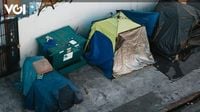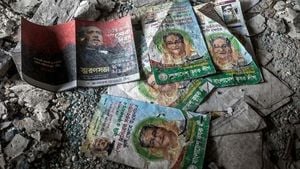On August 11, 2025, President Donald Trump dramatically expanded federal authority in Washington, D.C., declaring a public safety emergency and seizing control of the city’s police department. In a move that stunned local officials and reignited debates about the limits of presidential power, Trump invoked the District of Columbia Home Rule Act, temporarily placing the Metropolitan Police Department under federal command. Attorney General Pam Bondi was tapped to oversee the transition, with Defense Secretary Pete Hegseth by her side as the administration announced the deployment of 800 National Guard troops to the nation’s capital.
Trump’s actions followed a violent attack on a young administration staff member that had left the White House rattled. According to the New York Times, the president described the city as overrun by “bloodthirsty criminals” and “roving mobs of wild youth,” painting a grim portrait that sharply contrasted with official statistics. In reality, the Metropolitan Police Department reported a 26% drop in violent crime and a 7% decrease in overall crime in the first seven months of 2025 compared to the previous year. The city had logged just 1,584 violent crimes from January 1 through August 10, a figure representing a 30-year low.
Despite the numbers, Trump declared, “The homeless must move, IMMEDIATELY. We will give you a place to live, but stay away from the capital city. The criminals, you don’t need to move. We will imprison you where you should be,” as posted on his Truth Social platform. The president’s rhetoric and rapid federal intervention left many in Washington’s city government scrambling for answers. Charles Allen, a District of Columbia Council member representing Capitol Hill, expressed bewilderment: “He’s doing this because he can.” Allen noted that district leaders had “tons of questions,” including whether Police Chief Pamela Smith remained in charge. “We literally don’t know the answer right now,” Allen said, adding that police command staff had no advance warning of the federal takeover.
The president’s plan to expel homeless individuals from the city also stirred controversy. According to Community Partnership, an organization focused on reducing homelessness in D.C., approximately 3,782 single adults experience homelessness each night, most of whom are in emergency shelters or transitional housing rather than on the streets. The White House declined to explain what legal authority Trump would use to expel people from Washington, where the president only directly controls federal land and buildings. Questions about where displaced individuals would be housed remained unanswered as of Monday’s news conference.
Trump’s crackdown included the reassignment of 120 FBI agents to nighttime patrol duties in the city, a move reported by the New York Times as part of the administration’s broader effort to “restore law and order.” The president also threatened to send military forces into Washington “if needed” and suggested he might expand similar interventions to other cities, including Chicago, if local governments failed to address what he described as “out of control” crime rates.
Local and national reactions to the federal intervention were swift and divided. Brian Schwalb, the elected Attorney General of D.C., labeled the takeover “unprecedented, unnecessary and unlawful,” vowing to explore all legal options to protect the rights and safety of district residents. “We are considering all of our options and will do what’s necessary to protect the rights and safety of District residents,” Schwalb said in a statement.
Yet some federal lawmakers offered support for Trump’s actions. Representative James R. Comer of Kentucky, the Republican chairman of the House committee overseeing D.C. affairs, praised the president, saying, “President Trump is rightly using executive power to take bold and necessary action to crack down on crime and restore law and order in Washington, D.C.”
Trump’s moves in Washington echoed his earlier decisions in California, where, in the summer of 2025, he deployed nearly 5,000 National Guard troops to Los Angeles. The deployment was in response to protests against immigration raids and aimed at protecting federal agents conducting those operations. Most of those troops have since been withdrawn, but the episode left a lasting mark. The legal fallout continues: on August 11, a three-day trial began in a California federal district court to determine whether the U.S. military unlawfully engaged in civilian law enforcement when deployed to Los Angeles. The case, stemming from a lawsuit filed by Governor Gavin Newsom, centers on whether Trump’s federalization of California’s National Guard violated federal law limiting military involvement in civilian affairs. California’s lawyers argue that allowing the military to accompany immigration agents sets a dangerous precedent, while the Trump administration maintains its actions did not constitute law enforcement and that the relevant law is criminal, not civil.
Back in Washington, the president’s press conference meandered from policing to other national and international topics, including his upcoming meeting with Russian President Vladimir Putin and trade disputes with China. But it was the local impact that dominated headlines. The city’s police department, already under substantial federal oversight for adult criminal prosecutions, found itself at the center of a constitutional and political storm. The president’s critics noted the irony that Trump, who rarely ventured outside the White House during his tenure, was now portraying the city as a dystopian landscape in need of federal rescue.
Meanwhile, the administration’s focus on homelessness and crime came as local officials pointed to ongoing efforts to support vulnerable populations and maintain public safety. Mayor Muriel Bowser, for instance, had attempted to repeal the city’s “sanctuary city” law in her latest budget, though the city council ultimately removed that provision. Trump seized on the issue, declaring that Washington would no longer be “a sanctuary” for undocumented immigrants.
Outside the corridors of power, the president’s announcements sparked protests. A group called Free DC rallied near the White House, demanding an end to what they viewed as federal overreach. The city’s shelter system, already strained, braced for an influx of displaced individuals as Trump claimed his administration had begun removing homeless people from encampments in city parks. Yet, as the New York Times observed, Trump offered few specifics on how these individuals would be supported or where they would be relocated.
Trump’s assertion that Washington would be a “test lab” for Republican-led urban policy underscored the high stakes. “He’s using it as a test lab to prove that Republicans can clean up and run cities better than Democrats, and that the changes to come will set an example for blue cities across America,” the New York Times reported.
As the city’s residents, leaders, and legal experts grappled with the implications of Trump’s federal intervention, the broader questions of presidential authority, states’ rights, and the balance between public safety and civil liberties took center stage. With the administration’s plans still unfolding, all eyes remain fixed on the capital, where the boundaries of federal power and local governance are being tested in real time.




